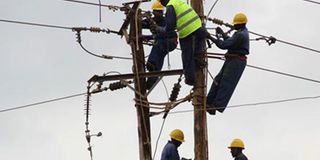What it costs to take power to consumers

The cost of electricity in Uganda continues to rise worsened by a weak Shilling. Photo by Abubakar Lubowa.
What you need to know:
Power tariffs have been increasing over time. However, as Nelson Wesonga found out, this is what it costs to take power to the consumer.
Electricity end–user tariffs are a function of the generation, transmission and distribution costs divided by the units generated minus the units lost.
The Bujagali hydropower plant, which generates 43.5 per cent of the electricity on Uganda’s national grid, sells each unit at the average of $0.11 (Shs398.75).
Eskom Uganda Limited generates 37.8 per cent of the power, and it sells each unit at $0.1 (Shs36.25).
Kakira Sugar Works generates 8 per cent of the electricity used, and sells it at Shs290.
Bugoye–Tronder, which produces 1.3 per cent of the power, charges Shs290, too, per unit.
All these companies sell their electricity to Uganda Electricity Transmission Company Limited (UETCL), the sole buyer of bulk electricity in Uganda.
This quarter (October to December), UETCL will spend Shs834.8b, up from Shs738.1b last quarter, to buy electricity from the generation companies.
UETCL sells the power to the distribution companies such as Umeme, Wenreco and Ferdsult at Shs270.7 per unit, for the power it transmits between 6am and 5pm.
From 6pm to 12am, when many people are in their homes and have turned on electrical gadgets, UETCL sells each unit at Shs324.8.
It charges Shs200.8 per unit at off–peak (from midnight to 6am when many people are asleep and their electrical gadgets are switched off).
Umeme, which distributes 97 per cent of the power, charges Shs295.4 during peak hours, Shs261.4 during shoulder hours and Shs202.4 at off peak hours.
We could not get distribution prices of West Nile Rural Electrification Company Limited and Ferdsult, which distribute electricity in Arua, Yumbe, Moyo as well as Adjumani and in Kibaale, Kanungu as well as Kyenjojo districts respectively.
The end–user tariffs also factor in the electricity generation, transmission and distribution companies’ return on investment (ROI) – profit.
Bujagali’s ROI is 19 per cent, UETCL’s 14 per cent, Umeme’s 20 per cent and Wenreco’s is 15.2 per cent.
The tariffs have a generation levy of between Shs0.9 and Shs1.5 and agreed loss caps, which varies from utility to utility.
Since 2014, the Electricity Regulatory Authority (ERA) has on a quarterly basis been reviewing end–user tariffs to reflect changes in the exchange rate, price of imported oil and inflation.
This is meant to ensure that tariffs are cost–reflective since many of the power utilities use imported machinery and spare parts, in the case of thermal plants, heavy fuel oil and dollar–denominated loans.
What electricity consumers are paying?
The end–user tariff for Umeme’s domestic consumers is Shs667.4 while Ferdsult’s domestic consumers pay Shs511.91 whereas Wenreco’s domestic consumers pay Shs610 for each unit.
Ferdsult’s commercial consumers pay Shs477.24, Wenreco’s Shs574.5 while Umeme’s Shs594.2 for each unit of electricity.
Umeme’s medium industrial consumers now pay Shs580.8 whereas its large industrial clients pay Shs389.6 for each unit.
A week ago, ERA increased the end–user tariffs by between Shs52.2 and Shs109.
The increments, which apply October through December, impact mainly on Umeme’s just over 600,000 customers.
Its domestic customers (households, shops, kiosks and the like) will, this quarter, pay Shs667.4 for each unit of electricity, up from Shs558.4 whereas welders and millers will pay Shs604.6 from Shs508.6; while medium industrial consumers’ tariffs have increased to Shs567.3 from Shs483.2.
Large industrial consumers will pay Shs381.1 for each unit, up from Shs328.7 while local authorities will pay Shs630.1, up from Shs527.7 per unit for street lighting.
This is the fourth increment in as many quarters, and, just like the previous ones, is largely attributed to the depreciation of the Shilling against the dollar.
A dollar that cost Shs3,301.8 in June now costs Sh3,578.17 – partly because of low exports and low remittances by Ugandans living and working abroad, which could have brought in dollars to shore up the Shilling.
Electricity companies incur dollar–denominated costs: commercial banks lend money to them in dollars, the companies use dollars to purchase electrical spare parts, fuel or, in the case of UETCL, electricity.
UETCL’s chief executive officer, engineer Eriasi Kiyemeba, told this newspaper on telephone that whenever the Shilling depreciates, they use more money to get few dollars to purchase inputs.
But Fred Muhumuza, an economist, says to mitigate the depreciation of the Shilling against the dollar, Uganda should produce more agricultural items for export. Uganda has a comparative advantage in agriculture, he says.
“We still have sufficient demand for agricultural products on the global market that we can tap,” Muhumuza said in a telephone interview.
“We also have to check our imports from Kenya, China and India,” he added.
As much as tourism is a good foreign exchange earner, he says “it is susceptible to the economic conditions, especially in the West.
During tough economic times in, say, Western Europe or the US, many of the potential tourists from those areas put off travelling to countries such as Uganda.
Equally, Simon D’Ujanga, the state minister for Energy, believes that tariffs can be brought down if the cost is subsidised, “but it is not sustainable”.
“Subsidies put stress on the budget. So the only alternative is to increase tariffs,” he explains.
Challenge
The increasing cost of electricity continues to be a challenge, especially to industrialisation, one of the key attributes that could drive growth and creating employment.



